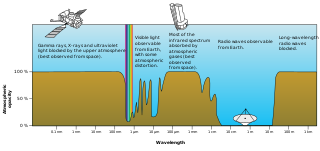
The Drake equation is a probabilistic argument used to estimate the number of active, communicative extraterrestrial civilizations in the Milky Way Galaxy.

The search for extraterrestrial intelligence (SETI) is a collective term for scientific searches for intelligent extraterrestrial life, for example, monitoring electromagnetic radiation for signs of transmissions from civilizations on other planets.

Frank Donald Drake was an American astrophysicist and astrobiologist.
Project Phoenix was a SETI project: in this case a search for extraterrestrial intelligence by analyzing patterns in radio signals. It was run by the independently funded SETI Institute of Mountain View, California, U.S.
An astronomical radio source is an object in outer space that emits strong radio waves. Radio emission comes from a wide variety of sources. Such objects are among the most extreme and energetic physical processes in the universe.

The Wow! signal was a strong narrowband radio signal detected on August 15, 1977, by Ohio State University's Big Ear radio telescope in the United States, then used to support the search for extraterrestrial intelligence. The signal appeared to come from the direction of the constellation Sagittarius and bore the expected hallmarks of extraterrestrial origin.
The Arecibo message is an interstellar radio message carrying basic information about humanity and Earth that was sent to globular star cluster M13 in 1974. It was meant as a demonstration of human technological achievement, rather than a real attempt to enter into a conversation with extraterrestrials. It has been noted that the low resolution of the image makes it infeasible for any extraterrestrial recipients to attach the intended meaning to most of its elements.
Project Cyclops is a 1971 NASA project that investigated how SETI should be conducted. As a NASA product the report is in the public domain. The project team created a design for coordinating large numbers of radio telescopes to search for Earth-like radio signals at a distance of up to 1,000 light-years to find intelligent life. The proposed design was shelved due to costs. However, the report became the basis for much of the SETI work to follow.

The Teen Age Message (TAM) was a series of interstellar radio transmissions sent from the Yevpatoria Planetary Radar to six solar-type stars during August–September 2001. The structure of the TAM was suggested by Alexander Zaitsev, Chief Scientist at Russia's Institute of Radio-engineering and Electronics. The message's content and target stars were selected by a group of teens from four Russian cities, who collaborated in person and via the Internet. Each transmission comprised three sections: a sounding, a live theremin concert, and digital data including images and text. TAM was humanity's fourth Active SETI broadcast and the first musical interstellar radio message.

The Allen Telescope Array (ATA), formerly known as the One Hectare Telescope (1hT), is a radio telescope array dedicated to astronomical observations and a simultaneous search for extraterrestrial intelligence (SETI). The array is situated at the Hat Creek Radio Observatory in Shasta County, 290 miles (470 km) northeast of San Francisco, California.

Astropulse is a volunteer computing project to search for primordial black holes, pulsars, and extraterrestrial intelligence (ETI). Volunteer resources are harnessed through Berkeley Open Infrastructure for Network Computing (BOINC) platform. In 1999, the Space Sciences Laboratory launched SETI@home, which would rely on massively parallel computation on desktop computers scattered around the world. SETI@home utilizes recorded data from the Arecibo radio telescope and searches for narrow-bandwidth radio signals from space, signifying the presence of extraterrestrial technology. It was soon recognized that this same data might be scoured for other signals of value to the astronomy and physics community.

The waterhole, or water hole, is an especially quiet band of the electromagnetic spectrum between 1420 and 1662 megahertz, corresponding to wavelengths of 21 and 18 centimeters, respectively. It is a popular observing frequency used by radio telescopes in radio astronomy.
SERENDIP is a Search for Extra-Terrestrial Intelligence (SETI) program originated by the Berkeley SETI Research Center at the University of California, Berkeley.

The Five-hundred-meter Aperture Spherical radio Telescope, nicknamed Tianyan, is a radio telescope located in the Dawodang depression (大窝凼洼地), a natural basin in Pingtang County, Guizhou, southwest China. FAST has a 500 m (1,600 ft) diameter dish constructed in a natural depression in the landscape. It is the world's largest filled-aperture radio telescope and the second-largest single-dish aperture, after the sparsely-filled RATAN-600 in Russia.
Active SETI is the attempt to send messages to intelligent extraterrestrial life. Active SETI messages are predominantly sent in the form of radio signals. Physical messages like that of the Pioneer plaque may also be considered an active SETI message. Active SETI is also known as METI. The term METI was coined by Russian scientist Alexander Zaitsev, who denoted the clear-cut distinction between Active SETI and METI:
The science known as SETI deals with searching for messages from aliens. METI deals with the creation and transmission of messages to aliens. Thus, SETI and METI proponents have quite different perspectives. SETI scientists are in a position to address only the local question “does Active SETI make sense?” In other words, would it be reasonable, for SETI success, to transmit with the object of attracting ETI’s attention? In contrast to Active SETI, METI pursues not a local and lucrative impulse, but a more global and unselfish one – to overcome the Great Silence in the Universe, bringing to our extraterrestrial neighbors the long-expected annunciation “You are not alone!”
SEVENDIP, which stands for Search for Extraterrestrial Visible Emissions from Nearby Developed Intelligent Populations, was a project developed by the Berkeley SETI Research Center at the University of California, Berkeley that used visible wavelengths to search for extraterrestrial life's intelligent signals from outer space.

Breakthrough Listen is a project to search for intelligent extraterrestrial communications in the Universe. With $100 million in funding and thousands of hours of dedicated telescope time on state-of-the-art facilities, it is the most comprehensive search for alien communications to date. The project began in January 2016, and is expected to continue for 10 years. It is a component of Yuri Milner's Breakthrough Initiatives program. The science program for Breakthrough Listen is based at Berkeley SETI Research Center, located in the Astronomy Department at the University of California, Berkeley.

The Berkeley SETI Research Center (BSRC) conducts experiments searching for optical and electromagnetic transmissions from intelligent extraterrestrial civilizations. The center is based at the University of California, Berkeley.

The NIROSETI is an astronomical program to search for artificial signals in the optical (visible) and near infrared (NIR) wavebands of the electromagnetic spectrum. It is the first dedicated near-infrared SETI experiment. The instrument was created by a collaboration of scientists from the University of California, San Diego, Berkeley SETI Research Center at the University of California, Berkeley, University of Toronto, and the SETI Institute. It uses the Anna Nickel 1-m telescope at the Lick Observatory, situated on the summit of Mount Hamilton, east of San Jose, California, USA. The instrument was commissioned on 15 March 2015 and has been operated for more than 150 nights, and is still operational today.

The following outline is provided as an overview of and topical guide to extraterrestrial life:











